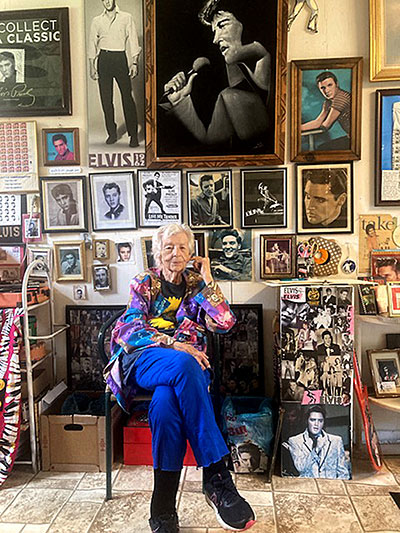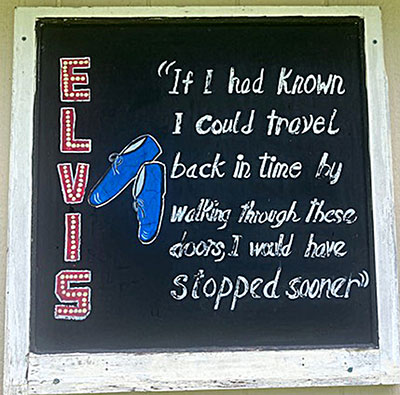
Just what if it didn’t really end in 1977 on the bathroom floor of a Memphis mansion? What if, instead, he has been spending his golden years right here, among the hills and hollers of the good ol’ southern Blue Ridge? Well, the absolute, unadulterated, somewhat but not really, true truth is—he has been. Sort of. For about the last 15 years. Guess I better back up a bit and explicate.
The day started out with lightning. No, I didn’t suffer a direct strike to my already COVID-weary brain, as you might be thinking by now. But to hear my perpetually electrical-storm-freaked-out wife tell it, I likely would have by now and probably will one day—if not for her. I just wanted to go fishing in the Smoky Mountains—but, as she ALWAYS does, she just had to go and look at the weather forecast for the area to which I was headed. That’s when the sermon (which I can recite by heart) began. (Hey! Maybe when they cut the Weather Service enough to change forecasting into foreguessing, she’ll stop paying attention and I can go fish in peace! Okay sorry, that’s not funny. I really, truly do not want our Weather Service gutted, okay?)
I’m often reminded, by someone who should know, that I might be a little crazy, but even she’ll admit I ain’t stupid. So, I eased the tension of the moment with a solemn promise not to set foot in woods or waters on this trip if even there was the slightest hint of an electrical storm brewing, and that I would not even remove from the travel tube any of my various graphite superconductors (fly rods). Of course, I sealed the deal by inviting her to go with me (told you I wasn’t stupid.) And then all was well and a good day lay ahead, not to mention a certain Smoky Mountain stream, alleged by some folks to hold four different strains of Salmoninae,—plus, I still had another compelling reason for this Smokies road trip concerning the aforementioned King of Rock & Roll.
As I crossed over Soco Gap and descended onto the Cherokee Qualla Boundary (despite the tourist-pleasing “reservation” signs at the entrances, their land is not actually a government reservation), I felt the familiar, fishwater-induced rush building up inside. And then, almost as quickly as it came on, the rush was quelled by a massive double clap of thunder. Within seconds, waves of wind-driven rain came at us head-on and hard, and I could barely see the lines on the extremely steep and winding mountain road. Looked like the fishing trip might be a wash (get it?), but I eased on down the mountain, praying hard we wouldn’t end up taking the fast and direct way down after missing one of the 26,000 hairpin curves.
We finally reached the valley floor, facing both a continuing torrent and the now certain fact there would be no fishing that day. After a few more bummed-out, rain-weary miles, suddenly a small sign by the road snapped me out of my funk and reminded me of my trip’s other purpose. With spirits now lifting, I was about to make a right turn straight into the parking lot of the semi-famous and much-beloved Cherokee Elvis Museum.

Mrs. Smith spoke with a sense of wonder and awe of the two live Elvis performances she attended in the early 70s, almost as if they had happened last week. She related how countless other fans had given her items for the museum over the years, and she shared the stories that came with each of those treasures. Every imaginable kind of memorabilia lines walls and shelves. Elvis lamps, glassware, shirts, paintings, toys, dolls, even an unopened set of Elvis Pez dispensers are some of the things you’ll see. There are hundreds of books on Elvis, records, tapes, concert tickets and souvenirs and the list goes on and on. If you love photographs and you are an Elvis fan then this is the place for you; there are literally hundreds.
But while we were certainly fascinated with the countless items wedged into this small space, paying tribute to one of the world’s best known and loved musical artists, we came to appreciate even more, Dee Smith, the warm, open and truly genuine person who chose many years ago to share, free of charge, her admiration for that artist.
Go there and you will find Mrs. Smith sitting in her favorite chair, small record player nearby, playing her favorite Elvis songs. She will smile an honest smile, welcome you warmly and within a few minutes you, too, will declare that Elvis lives and can readily be seen at an amazing little spot (right next to that special trout stream I didn’t get to fish,) deep in the Great Smoky Mountains.
NOTE: The Cherokee Elvis Museum is located in Cherokee, NC on Highway 19, right beside Littlejohn’s Campground and a spit and a whistle from Soco Creek. The hours are 11:00 am until 3:00 pm, Mon thru Fri and closed on Sat and Sun. Ph. 828-497-0791.
David Arthur Ramsey is an outdoor photographer, writer and conservationist, born and raised in the mountains of northeastern Tennessee. His outdoor writing and photography have been published locally, regionally and nationally and are most often associated with work to preserve and protect threatened lands and waters throughout the Southern Appalachian Mountains.